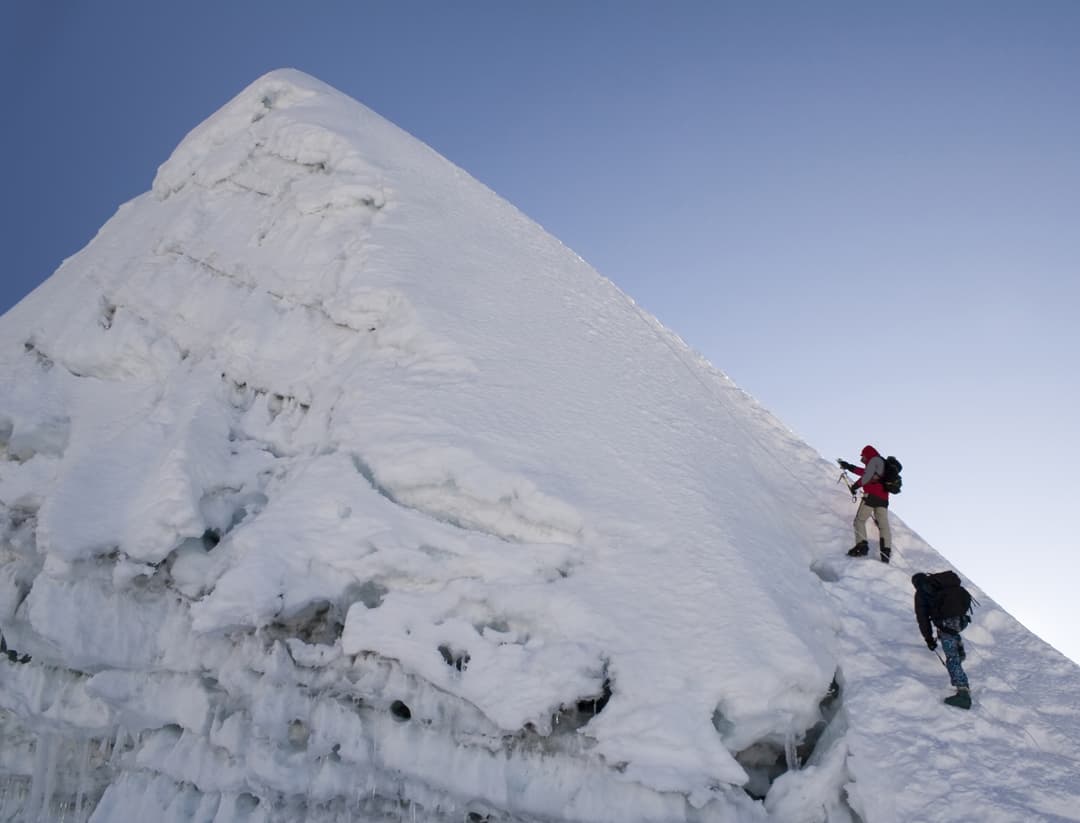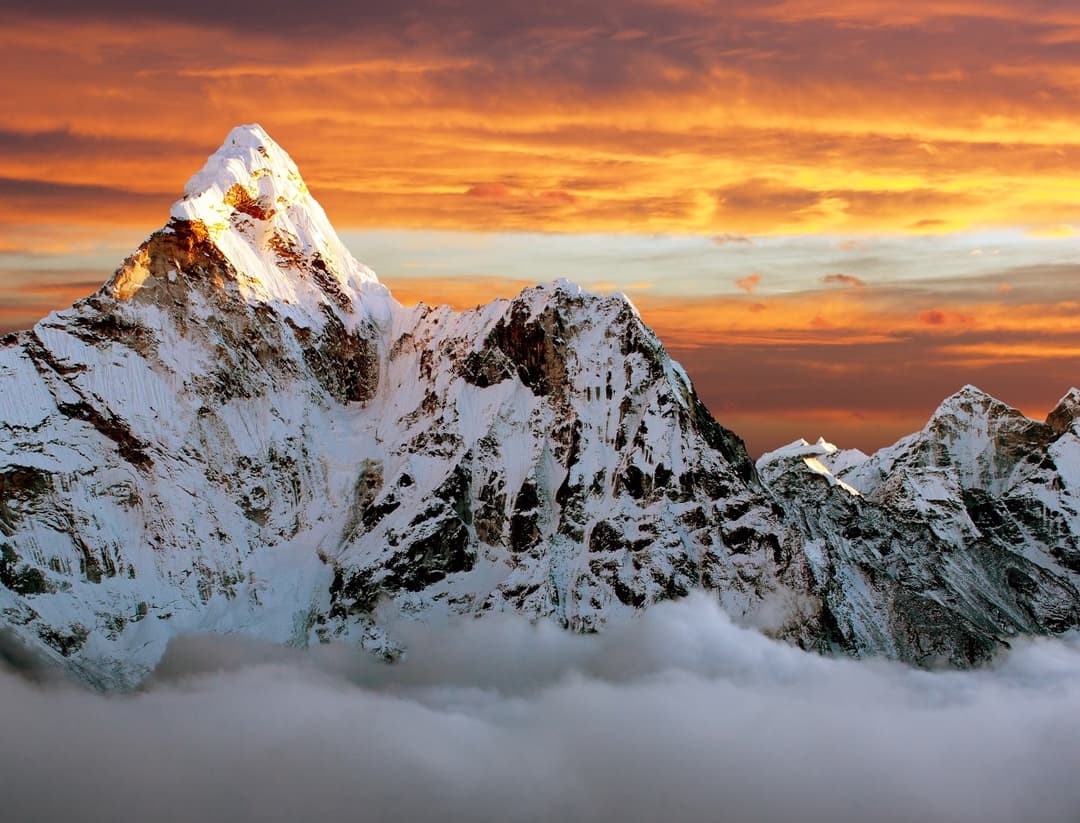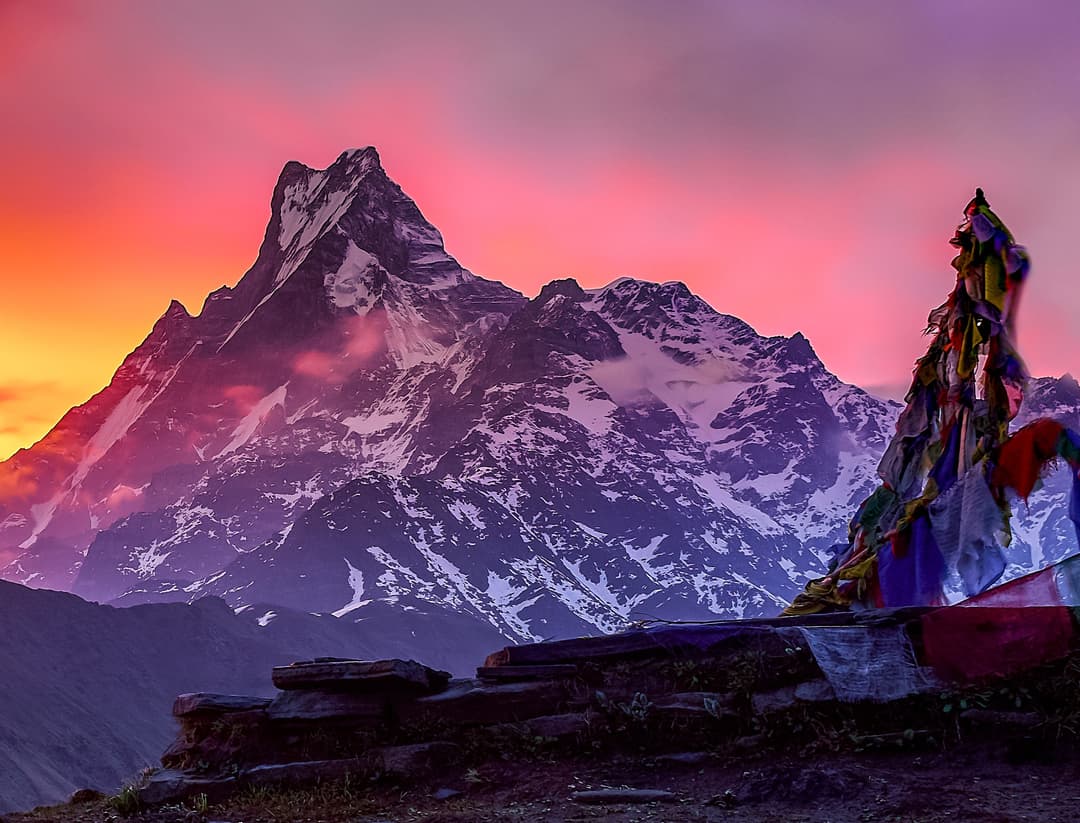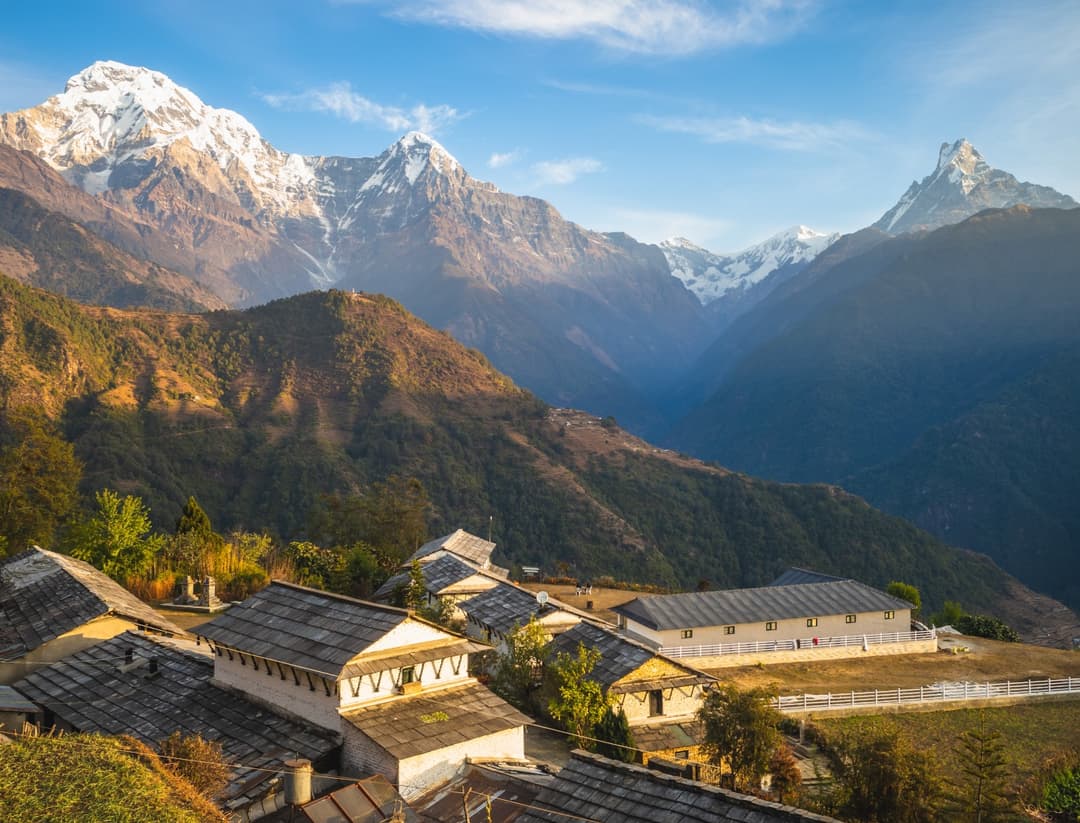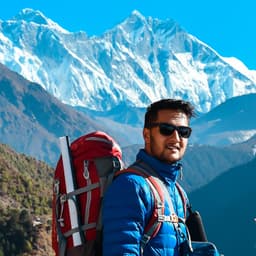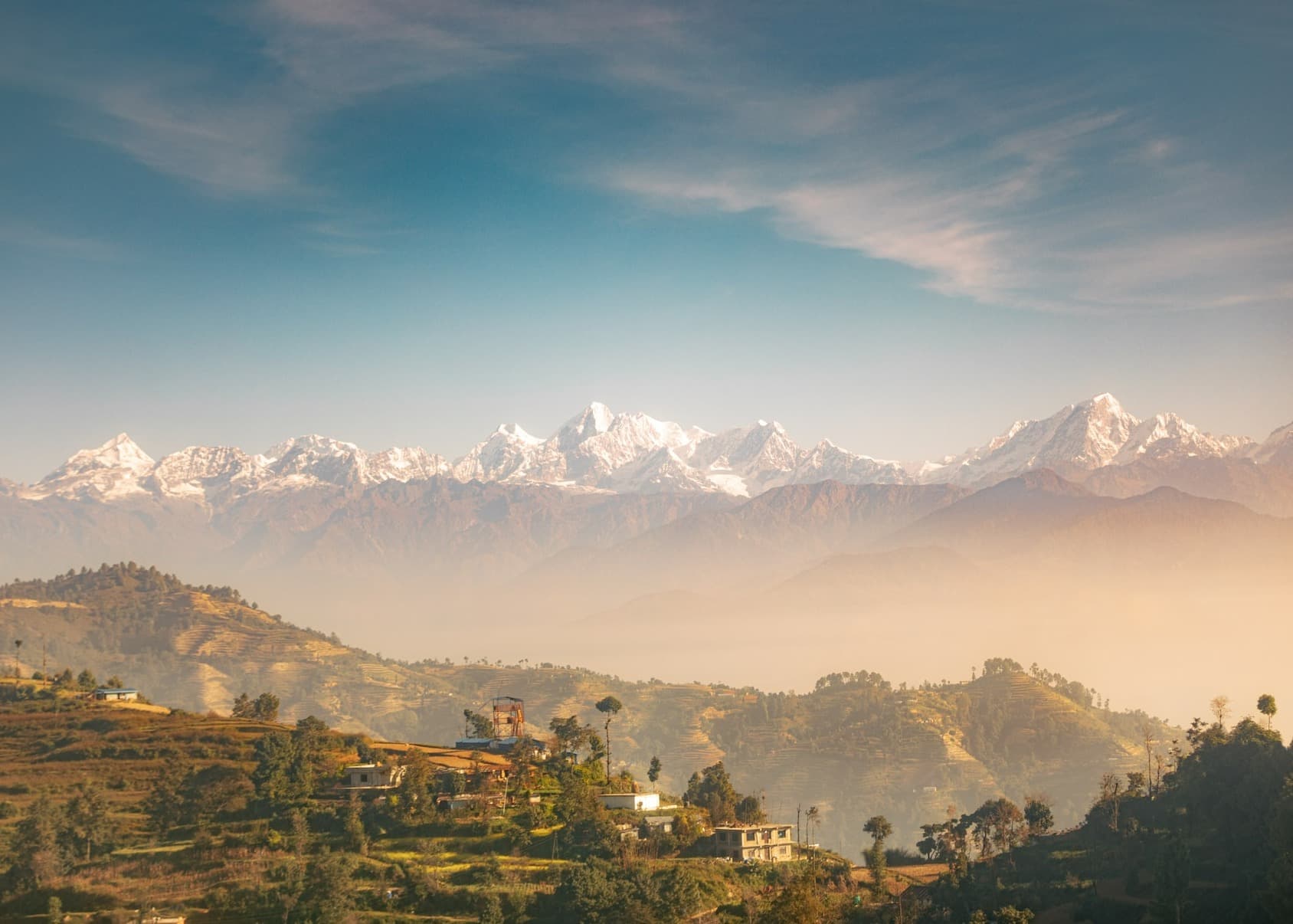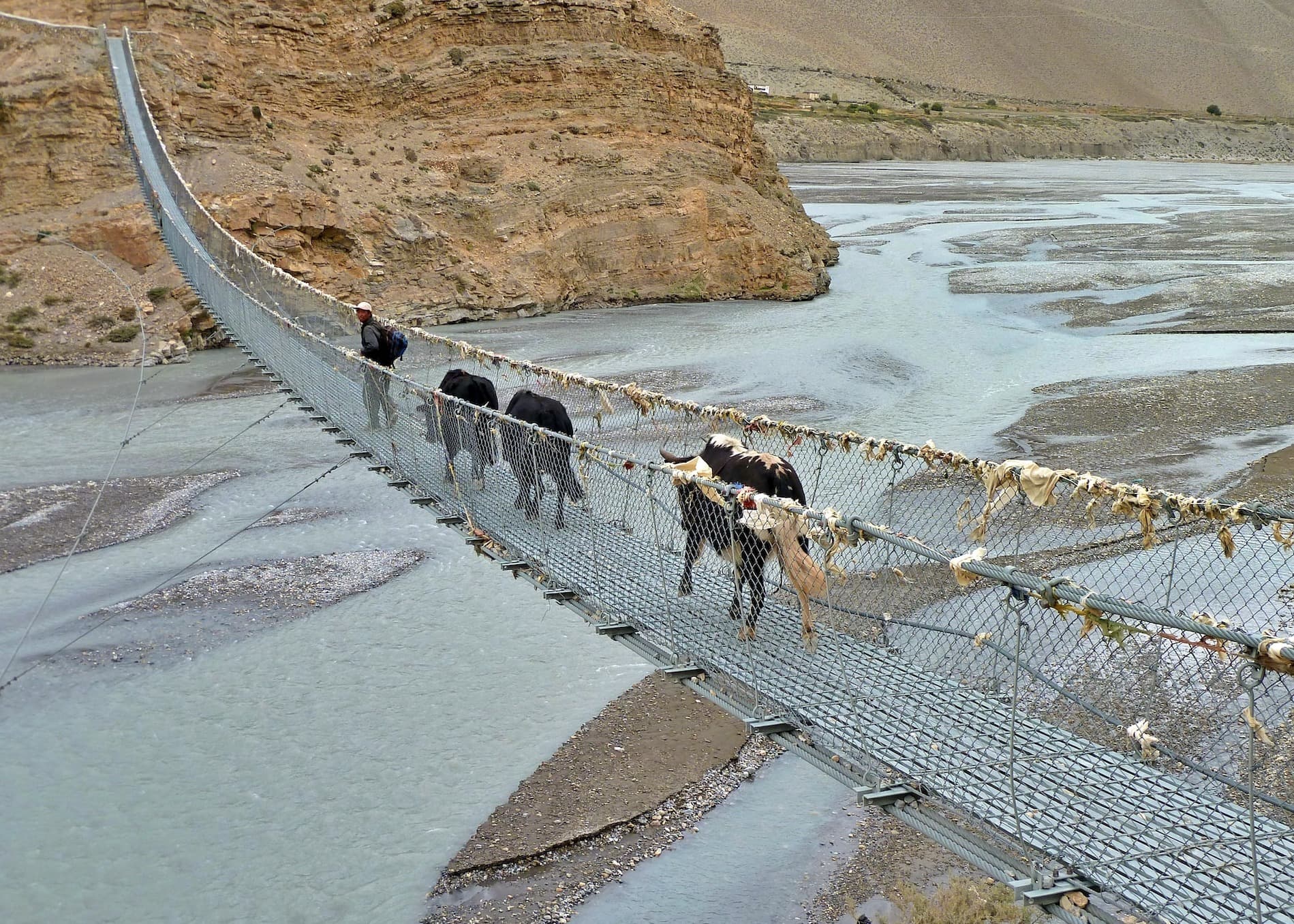- Why Everest Base Camp?
- Can I trek to Everest Base Camp without a Guide in 2023-24?
- Trekking to South Base Camp Located at Nepal
- Trekking to North Base Camp
- Weather during Everest Base Camp Trek
- How much money do I need for Everest Base Camp Trek
- How hard is Everest Base Camp Trek
- Everest Base Camp Trek Permit
- Accommodation on Everest Base Camp Trek
- Food in Everest Base Camp Trek
- Everest Base Camp Alternative Routes
- Everest Base Camp Route Map
- Tipping the porter and guide on EBC
Everest Base Camp is a popular trekking destination located in the Khumbu region of Nepal, at the base of Mount Everest, the highest mountain in the world. The trek to Base Camp typically takes about 12-15 days and is a challenging yet rewarding adventure that offers stunning mountain views, unique Sherpa culture, and a chance to witness some of the world's most spectacular natural landscapes. The trek to Everest Base Camp is suitable for people of all ages and fitness levels with proper preparation and training.
|
Distance |
130km (80 miles) |
|
Location |
Khumbu region (northeastern part of Nepal.) |
|
Max. Altitude |
5545m / 18192ft (Kala patthar) |
|
Acclimatization Location |
Dingboche & Namche Bazaar |
|
Days Required |
15 Days |
|
Difficulty Level |
Challenging |
|
Permits |
Sagarmatha National Park Entry Permit, Khumbu Pasang Lhamu Rural Municipality Permit and TIMS Card. |
|
Accommodation |
Tea houses, Lodges, and Camping. |
Why Everest Base Camp?
Everest Base Camp (EBC) is a popular trekking destination because it offers a once-in-a-lifetime experience of being in the heart of the Himalayas and seeing the world's tallest peak up close. Trekking to EBC provides an opportunity to witness the stunning beauty of the region, including breathtaking views of snow-capped mountains, glaciers, and beautiful landscapes.
In addition to the natural beauty of the region, trekking to EBC also allows trekkers to experience the unique culture and hospitality of the Sherpa people, who have lived in the area for centuries. Trekking to EBC also provides a physical challenge for those seeking adventure and a sense of accomplishment.
The journey to EBC is not only a trek but also an opportunity to explore and learn about the local culture, traditions, and history. The trek provides a chance to visit Buddhist monasteries, traditional Sherpa villages, and learn about the local customs and lifestyle.
Overall, trekking to Everest Base Camp is a bucket-list adventure for many people seeking a unique and unforgettable experience in one of the most spectacular regions of the world.
Can I trek to Everest Base Camp without a Guide in 2023-24?
In the past, solo trekking to Everest Base Camp was allowed without any legal restrictions. However, it is recommended to have prior trekking experience, knowledge of the route, and familiarity with high-altitude trekking challenges if choosing to trek solo.
But now Nepal Tourism Board (NTB) and Trekking Agencies' Association of Nepal (TAAN) have implemented a new rule stating that trekkers cannot do trekking in mountain areas without a licensed guide and a porter. This rule will be implemented from 1st April 2023 and applies to several popular trekking destinations in Nepal, including the Everest region, Annapurna region, and Langtang region.
The purpose of this rule is to ensure the safety of trekkers, as well as to create employment opportunities for local guides and porters. The licensed guides and porters have undergone training and have knowledge of the local culture, language, and geography, which can be helpful during the trek.
Trekking to South Base Camp Located at Nepal
The journey to Everest Base Camp in Nepal usually starts with a flight from Kathmandu to Lukla, a small town in the Everest region. The flight is considered one of the most scenic and thrilling flights in the world, offering breathtaking views of the Himalayas. From Lukla, the trek to Everest Base Camp begins, which usually takes around 12-14 days.
The trekking route passes through picturesque Sherpa villages, alpine forests, suspension bridges, and rugged mountain trails. The first few days of the trek are relatively easier, with gradual ascents and descents. As the trek progresses, the altitude gradually increases, and the terrain becomes more challenging.
The trek follows the Dudh Koshi river valley and passes through Namche Bazaar, the largest town in the Khumbu region. Namche Bazaar is a bustling trading center and serves as a hub for trekkers and mountaineers. From Namche, the trek continues to Tengboche, famous for its ancient Buddhist monastery and stunning views of Mount Everest and other peaks.
The trek then heads towards Dingboche, a picturesque village surrounded by high mountains and pastures. At this point, trekkers may experience symptoms of altitude sickness, and it is essential to acclimatize properly. After a rest day in Dingboche, the trek continues towards Gorak Shep, the last settlement before Everest Base Camp.
From Gorak Shep, trekkers hike to Kala Patthar, a small hill with a panoramic view of Mount Everest, the Khumbu glacier, and other peaks. The final leg of the trek leads to Everest Base Camp, which is located at the foot of the Khumbu icefall. The base camp serves as the starting point for climbers attempting to summit Mount Everest.
After spending some time at Everest Base Camp, trekkers retrace their steps and descend back to Lukla. The entire trek covers around 130 kilometers and involves hiking for around 6-7 hours per day on average. The best time to undertake the trek is from March to May and from September to November when the weather is favorable, and the views are stunning.
Itinerary for to South Base Camp
Day 1: Arrival at Kathmandu (1,300m/4,265 ft)
Day 2: Sightseeing around Kathmandu Valley and Trek preparation (1,300m/4,265 ft)
Day 3: Fly to Lukla from Kathmandu, 30mins and trek to Phakding (2,610m/8,563ft) 3-4 hrs
Day 4: Trek from Phakding to Namche Bazaar (3,440m/11,280ft) 5-6 hrs
Day 5: Acclimatization at Namche Bazaar (3,440m/11,286ft)
Day 6: Trek from Namche Bazaar to Tengboche (3,860/12,664ft) 4-5 hrs
Day 7: Trek from Tengboche to Dingboche (4,410/14,469ft) 5-6 hrs
Day 8: Acclimatization at Dingboche (4,410/14,469ft)
Day 9: Trek from Dingboche to Lobuche (4,910m/16,109ft) 4-5 hrs
Day 10: Trek from lobuche to Gorakshep -Everest Base Camp (5,364m/17,598ft) and back to Gorakshep (5,140m/16,864ft) 8-9 hrs
Day 11: Hike to Kala Patthar (5,545m/18,192ft) and trek to Pheriche (4,240m/13,911ft) 8-9 hrs
Day 12: Trek from Pheriche to Namche Bazaar (3,440m/11,280ft) 6-7 hrs
Day 13: Trek from Namche Bazaar to Lukla (2,840m/9,318ft) 6-7 hrs
Day 14: Fly from Lukla to Kathmandu (1,300m/4,265ft), Farewell Dinner
Day 15: Departure Day
Trekking to North Base Camp
This route has been closed by Chinese government from 2019 but it is expected to re-open from May 2023. The route to the North Base Camp typically begins in the Tibetan city of Lhasa, from where climbers travel by road to the town of Shigatse. From Shigatse, they proceed to the town of Tingri, where they will spend a day or two acclimatizing to the high altitude.
After Tingri, climbers continue on to the Rongbuk Monastery, where they can either hike or take a vehicle to reach the "tourist Base Camp," which is located halfway between the Rongbuk monastery and the actual climbers' Base Camp. From there, climbers must trek on foot to reach the actual climbers' Base Camp, which is situated at the foot of the Rongbuk glacier.
The "tourist Base Camp" is intended for visitors who want to see Mount Everest up close, and it provides basic facilities such as food, lodging, and medical aid. On the other hand, the climbers' Base Camp is primarily used by mountaineers who are attempting to climb Mount Everest, and it is equipped with more specialized equipment and services to support their climb.
From the actual climbers' Base Camp, climbers must traverse the glacier, ascend the North Col, cross the famous Three Pinnacles, and climb the Northeast Ridge to reach the summit of Mount Everest. The route to the summit is challenging, and climbers must be prepared to face high altitude, extreme weather conditions, and difficult terrain along the way.
Itinerary for to South Base Camp
Day 1: Drive from Kathmandu to Gyirong (1700m/8900ft)
Day 2: Drive from Gyirong to Old Tingri (4300m/14108ft)
Day 3: Drive from Old Tingri to Everest Base Camp (5200m/17060ft)
Day 4: Drive from Everest Base Camp to Shigatse (3845m/12614ft)
Day 5: Drive from Shigatse to Gyantse to Lhasa (3656m/11995ft)
Day 6: Lhasa City Tour and Farewell Dinner
Day 7: Departure Day
Weather during Everest Base Camp Trek
The weather in Everest Base Camp varies depending on the season. Here is an overview of the best time for everest base camp trek.
Spring (March to May):
Temperatures: During the day, temperatures range from 10°C to 20°C (50°F to 68°F). At night, temperatures can drop to around -10°C to -5°C (14°F to 23°F).
Weather: Spring is known for clear skies and stable weather conditions. However, occasional snowfall or rain showers are possible.
Summer/Monsoon (June to August):
Temperatures: Daytime temperatures range from 15°C to 25°C (59°F to 77°F). Nighttime temperatures can drop to around 5°C to 10°C (41°F to 50°F).
Weather: The summer months bring the monsoon season, characterized by frequent rain showers and cloudy conditions. The trails can be slippery, and visibility may be reduced. Landslides and avalanches are also more common during this time.
Autumn (September to November):
Temperatures: Daytime temperatures range from 10°C to 20°C (50°F to 68°F). Nighttime temperatures can drop to around -10°C to -5°C (14°F to 23°F).
Weather: Autumn is the most popular season for trekking to Everest Base Camp due to its clear skies, stable weather, and excellent visibility. However, temperatures can still be quite cold at higher altitudes.
Winter (December to February):
Temperatures: Daytime temperatures range from -5°C to 5°C (23°F to 41°F). Nighttime temperatures can drop to as low as -20°C to -15°C (-4°F to 5°F).
Weather: Winter brings cold temperatures and occasional snowfall. The higher altitudes can experience strong winds and freezing conditions. Trekking during winter requires proper equipment and experience.
It's important to note that weather conditions in the Everest region can be unpredictable, and temperatures can vary significantly at higher altitudes. It's advisable to check the latest weather forecasts and consult with local guides or trekking agencies for the most up-to-date information before planning your trek.
How much money do I need for Everest Base Camp Trek
|
For a single person |
USD 1550 |
|
For 2-4 persons |
USD 1500 each |
|
For 5-8 persons |
USD 1440 each |
|
For a group of more than 9 people |
USD 1380 each person |
The cost includes all necessary trekking permits, accommodation, meals, transportation, and an experienced guide. You will also be provided with a porter to carry your luggage during the trek.
How hard is Everest Base Camp Trek
The Everest Base Camp trek is known for its challenging nature, making it a test of physical and mental strength. One of the main factors contributing to the difficulty level is the high altitude. The trek takes you to elevations above 5,000 meters (16,000 feet), where the air becomes thin and oxygen levels decrease.
The duration of the trek, typically around 12 to 14 days, adds to the challenge. You'll be hiking for several hours each day, covering a distance of approximately 130 kilometers (80 miles).
The terrain is varied, with steep ascents, rocky paths, and challenging sections. The weather conditions can also be unpredictable, ranging from clear skies to snowfall and strong winds. This requires proper preparation and the right gear to withstand the elements.
Physical fitness and endurance are essential for the Everest Base Camp trek. Regular exercise and training prior to the trek, focusing on cardiovascular endurance, leg strength, and stamina, can help prepare your body for the demanding journey. Mental resilience is equally important, as the trek can be physically and mentally taxing. It requires determination, perseverance, and the ability to push through fatigue and discomfort.
If you want to know more information on how to prepare for everest base camp trek then you can check our blog How to Prepare for Everest Base Camp Trek: A Comprehensive Guide
Everest Base Camp Trek Permit
To trek to Everest Base Camp, you need to obtain two main permits: the Sagarmatha National Park Entry Permit and the Khumbu Pasang Lhamu Rural Municipality Permit.
Sagarmatha National Park Entry Permit: The Sagarmatha National Park is a protected area through which the Everest Base Camp trek passes. To enter the park, you need to obtain the Sagarmatha National Park Entry Permit. This permit helps fund conservation and preservation efforts in the region.
- Price for foreigners: NPR 3,000 (approximately USD 30)
- Price for SAARC nationals: NPR 1,500 (approximately USD 15)
This permit allows entry into the Sagarmatha National Park, which is a protected area and home to Mount Everest.
TIMS (Trekkers' Information Management System) Card: The TIMS card is another important permit required for trekking in the Everest region. It is aimed at maintaining a record of trekkers and ensuring their safety and security. The TIMS card can be obtained from the Nepal Tourism Board office in Kathmandu or through authorized trekking agencies.
- Price for SAARC nationals: NPR 1,000
- Price for foreigners: NPR 2,000
The price of TIMS Card can be pay via Online.
Local Government Permits: In addition to the national park permit and TIMS card, there are certain local government permits that may be required depending on the specific route you take. For example, if you choose to trek through the Gokyo Lakes, you will need an additional permit known as the Gokyo-Ri Trek Permit.
Price for all trekkers: NPR 2,000 (approximately USD 20)
This permit is specific to the Khumbu region and is required to enter areas beyond Monjo village, which is the entrance to the Sagarmatha National Park.
Accommodation on Everest Base Camp Trek
Teahouses/Lodges: These are basic guesthouses located in villages along the trekking route. They offer a range of amenities such as private or shared rooms, communal dining areas, and shared bathroom facilities. The quality and comfort of teahouses can vary, with some providing more basic facilities while others offer relatively better services.
Room Types: Most teahouses offer twin or double rooms with basic beds, blankets, and pillows. Some teahouses may also have dormitory-style rooms with multiple beds for budget-conscious travelers. Keep in mind that rooms may be small and simple, with limited privacy and amenities.
Dining Facilities: Teahouses usually have dining areas where trekkers can enjoy meals. They serve a variety of local and international dishes, including Nepali, Tibetan, Indian, and Western cuisines. The availability of food options can vary depending on the location and altitude.
Availability and Crowding: During the peak trekking seasons, especially in spring and autumn, popular teahouses along the route can get crowded. It's advisable to have a guide or porter who can help secure accommodation in advance or find alternatives if necessary.
Charging and Wi-Fi: Electricity is available in most teahouses, but it may be limited and unreliable. Charging electronic devices may require an additional fee. Wi-Fi access is also available in some teahouses, but it may be slow and expensive due to the remote location.
Toilet and Shower Facilities: Teahouses generally have shared bathroom facilities with squat toilets or western-style toilets. Hot showers are available at an extra cost, and the availability of hot water may vary depending on the teahouse and altitude.
Food in Everest Base Camp Trek
Teahouse Meals: Along the trekking route, teahouses provide meals for trekkers. These teahouses have menus offering a variety of dishes, including dal bhat (a traditional Nepali meal with rice, lentil soup, and vegetables), momo (dumplings), noodle soups, fried rice, pasta, pancakes, and more. The menus may also include options for breakfast, such as omelets, porridge, toast, and tea or coffee.
Vegetarian and Non-vegetarian Options: Teahouses typically offer both vegetarian and non-vegetarian dishes. Vegetarian options often include vegetable curries, fried rice, noodles, and lentil soups. Non-vegetarian options may include chicken, yak, or buffalo meat dishes, such as curries or stir-fries. Please note that meat options may be limited or not available in some teahouses at higher altitudes.
Hygiene and Safety: It's important to maintain proper hygiene standards while eating on the trek. Choose teahouses that follow good food handling practices and have a reputation for cleanliness. It's also advisable to stick to freshly cooked food and avoid raw or uncooked items that may pose a higher risk of contamination.
Safe Water: It is recommended to avoid tap water and unfiltered water sources on the trek to prevent waterborne illnesses. Bottled water is available for purchase at teahouses, but it can be expensive at higher altitudes. Alternatively, you can bring water purification tablets or a water filter to treat water from local sources.
Snacks and Energy Bars: It's a good idea to carry some energy bars, nuts, and snacks with you during the trek. These can provide quick energy boosts between meals or during long hiking days. Snacks like chocolate bars, trail mix, and protein bars are commonly available at teahouses along the route as well.
Special Dietary Requirements: If you have special dietary requirements or food allergies, it's advisable to inform your guide or teahouse staff in advance. While they will try their best to accommodate your needs, please note that the options may be limited to remote areas.
Overall, the food on the Everest Base Camp trek provides nourishment and energy for trekkers, with a mix of local flavors and familiar international dishes. Enjoying a warm meal at a teahouse after a day's trekking is a great way to refuel and experience the local cuisine.
Everest Base Camp Alternative Routes
Gokyo Lakes Trek: This trek takes you through the Gokyo Valley and offers magnificent views of the Himalayan range and the Gokyo Lakes. The trek starts from Lukla and takes around 12 days to complete.
Three Passes Trek: This route is a challenging trek that takes you through three high passes - Kongma La, Cho La, and Renjo La. The trek offers spectacular views of the Himalayan range and takes around 18 days to complete.
Everest Base Camp via Helicopter: For those who have limited time or are unable to complete the trek on foot, a helicopter ride to Everest Base Camp is an alternative option. This allows trekkers to enjoy the stunning views of the Himalayan range and reach the base camp in just a few hours.
These are just a few alternative routes to the Everest Base Camp Trek. Each route offers unique experiences and challenges, and trekkers should choose a route based on their preferences and fitness level.
Everest Base Camp Route Map
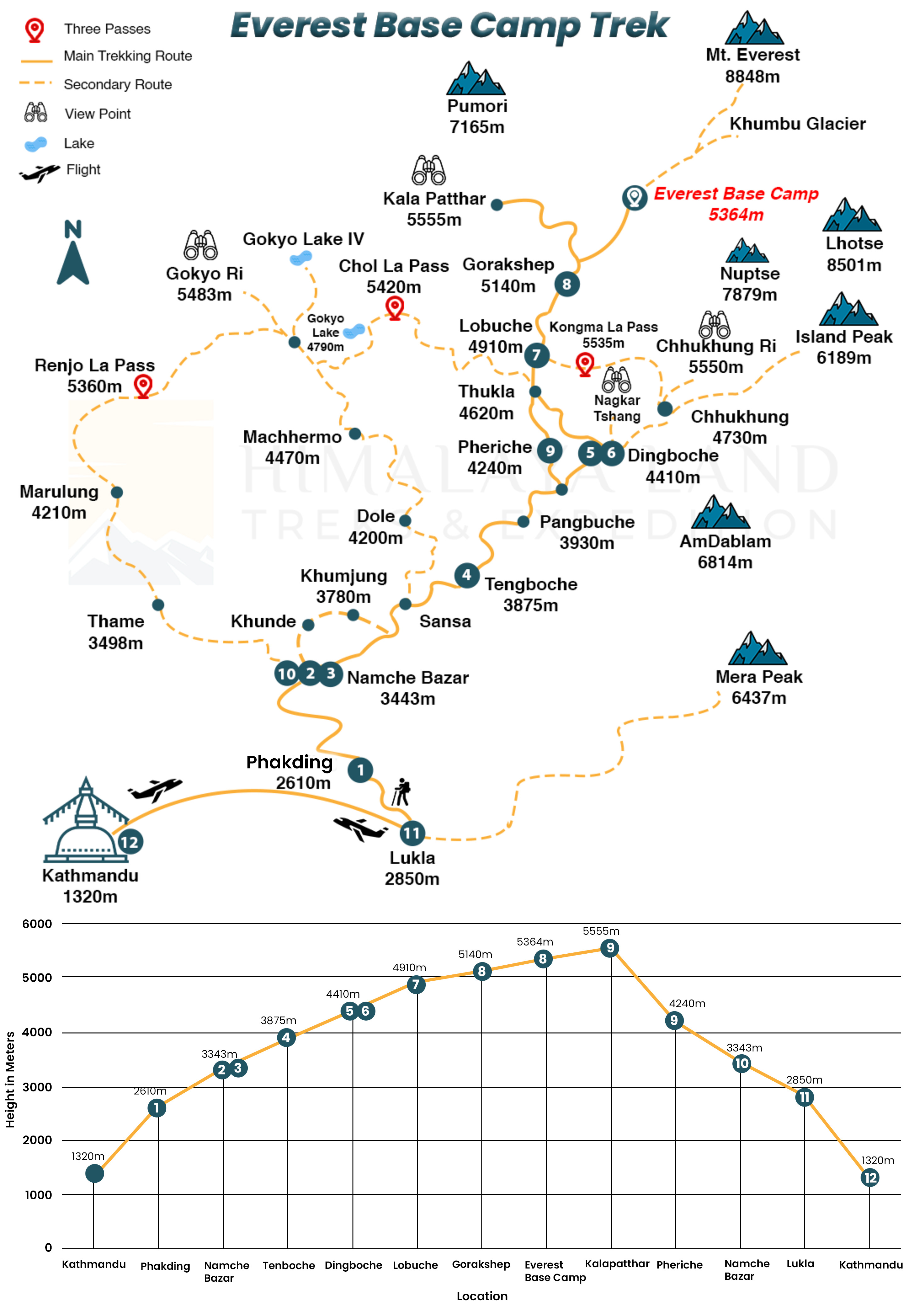
Tipping the porter and guide on EBC
Tipping is a common practice on the Everest Base Camp trek as a gesture of appreciation for the services provided by the porters and guides. While tipping is not mandatory, it is customary and considered a part of the trekking culture in the region. Here are some guidelines regarding tipping for porters and guides:
Porters: Porters play a crucial role in carrying your heavy luggage during the trek. It is customary to tip them at the end of the trek. The recommended tipping amount for a porter is around USD 20-25 per day, depending on the duration and difficulty of the trek. You can give the tip directly to each porter or hand it over to the trekking agency, who will distribute it among the porters.
Guides: Trekking guides provide valuable assistance, guidance, and local knowledge throughout the journey. Tipping your guide is also customary as a token of appreciation. The recommended tipping amount for a guide is around USD 35-40 per day, depending on the quality of service provided. Again, you can give the tip directly to the guide or through the trekking agency.
It's important to note that these are general guidelines, and the actual tipping amount is ultimately at your discretion. If you are trekking with a group, it is common to pool the tips together and give them as a collective tip.
It's advisable to carry enough cash in smaller denominations to provide tips and other expenses during the trek, as there are limited ATM facilities available along the route.
In conclusion, trekking to Everest Base Camp is a once-in-a-lifetime adventure that offers a unique opportunity to witness the stunning natural beauty of the Himalayas, explore the rich culture and traditions of the Sherpa people, and challenge oneself physically and mentally. The journey to EBC is a spiritual experience, providing trekkers with a sense of peace and serenity amidst the stunning landscape.
Overall, the trek to Everest Base Camp is an unforgettable adventure that leaves trekkers with a sense of accomplishment and a lifetime of memories. Whether for adventure seekers or those seeking a spiritual experience, trekking to Everest Base Camp is a must-do bucket-list experience.



